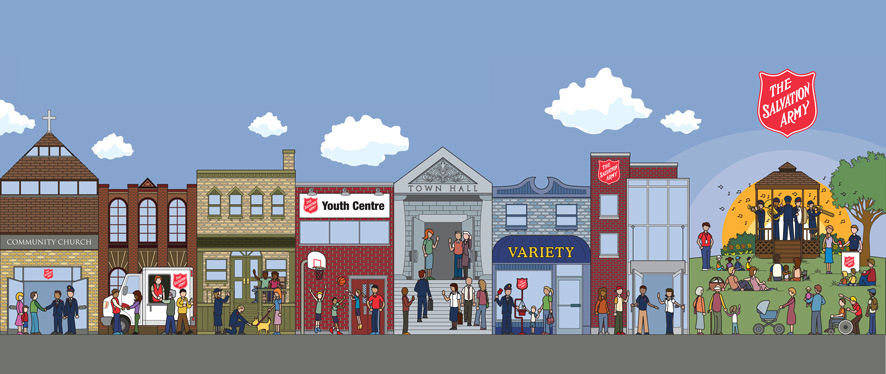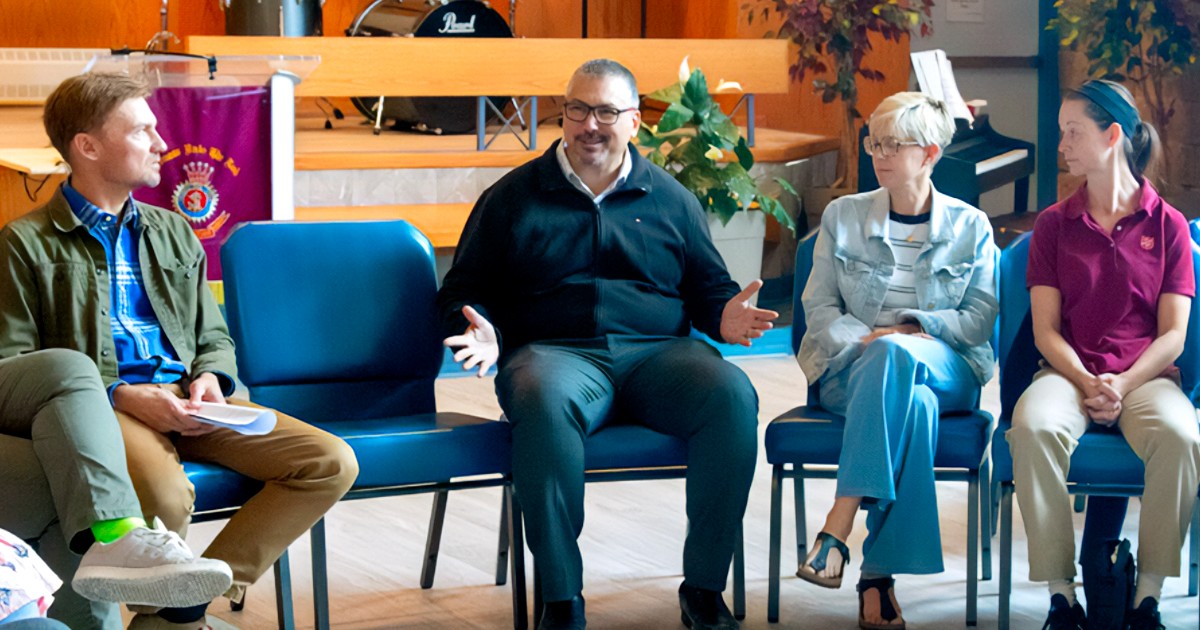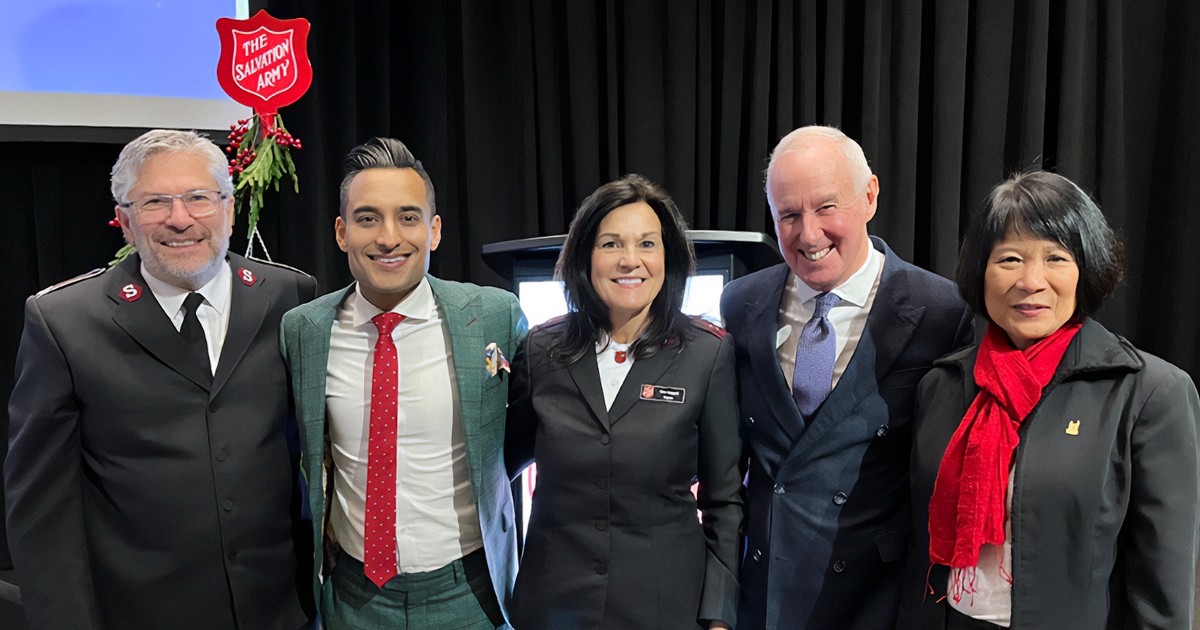In the early days of The Salvation Army, people told William Booth, “We can do with your social operations, but we can't do with your religion; we don't want it.” Booth responded, “If you want my social work, you have got to have my religion; they are joined together like the Siamese twins, to divide them is to slay them.” This has been the Army's mission since the beginning, to hold together word and deed, proclamation and demonstration, evangelism and social action. Today it is known as integrated mission.
The topic of integrated mission has been around for a long time. We have tried to understand it, define it and label it. It has become a strategic priority from an international, territorial and divisional level. And yet it continues to lack a clear definition.
General William Booth gave us the motto, “Heart to God and Hand to Man,” General John Gowans gave us “Save Souls, Grow Saints and Serve Suffering Humanity” and General Linda Bond (Rtd) gave us “One Army, One Mission, One Message.” All three clearly outline the importance of integrated mission.
So what is it and are we doing it? The Salvation Army is known for sharing the love of God through practical ministry, reaching out to a needy world with love in action. We seek to be the hands and feet of Jesus, caring for the hurting, broken, lonely, dispossessed and lost.
John's Gospel helps us understand how Jesus lived out integrated mission. “The Word became flesh and blood, and moved into the neighbourhood” (John 1:14 The Message). Jesus lived, walked, ate and prayed with the people he met. He had no comfortable building or programs to invite people to, and yet lives were transformed. The Apostles, including Paul, were followers of Christ, not because he was popular or rich or well-educated, but because of the relationship that Jesus built with them. For people who spent every day with him and those who only met him once, an encounter with Jesus was transformative.
Integrated mission works the same way today. If we live every day in the presence of the one who created us, who loves us and calls us to be his hands and feet, then we will live in integrated mission. It's not enough to write “everyone is welcome” on a sign outside the church. We need to build relationships in the name of Christ by going where the people are and not expect them to come to us.
God changes the hearts of people through relationships. We need to be preaching from our pulpits the importance of our relationship with Jesus Christ. We need to be preaching “integral mission,” which emphasizes the need to be a missional church. It is integral to who we are as Christ's disciples to help build the body of believers. In Matthew's Gospel, Jesus instructs his disciples to “go and make disciples of all nations, baptizing them in the name of the Father, Son and Holy Spirit” (Matthew 28:19). The missional church empowers its people to be the church in the community. The missional church challenges its people to live out the good news in their community. The missional church recognizes that every believer embodies the life of the church in their neighbourhoods, schools and workplaces, each one telling God's story in the context of compassionate, genuine relationships.
Integrated mission has no boundaries. It is not corps ministry here and social ministry over there. It is simply the expression of love, care, compassion, respect and dignity given in the name of Christ wherever we find ourselves. In Called to be God's People, Commissioner Robert Street quotes Warren Johnson: “Service is a practical ministry. It is not only a reaching into the body of believers with the heart of a servant, it is also a reaching out into a desperate and dying world with love in action.” He adds: “A giant leap forward for the new believer is to comprehend the essence of God's call to men and women to serve and minister to those who cross our paths every day of the week. God wants to use us in the lives of other people.” It is about being there at the centre of crisis to help the most vulnerable. In the midst of fire and flood, tsunami and earthquake, the Army serves with no hesitation or discrimination.
Integrated mission is also about helping to build the capacity of people while sharing the love of God. Our position statement on human diversity reads: “We seek to treat all people with dignity and respect in response to Jesus' call to love our neighbours as ourselves. We oppose oppression or unjust discrimination based on such differences as race, gender, age, belief, lifestyle, economic status, sexual orientation, or physical or mental ability. We believe that diversity strengthens and shapes community and ministry. Therefore, in our community services, employment practices and church life, we will seek to actively promote sensitivity, understanding and communication in both intent and practice.”
Integrated mission is about building bridges. A demographic study of Ottawa prompted Bethany Hope Centre to move from a neighbourhood they had been in for more than 100 years to the west side of the city, where the clients who were using their services lived. Along with their counselling and parenting programs, the added “chapel” offers worship and spiritual care to the program and greater community. Kelowna Community Church, B.C., which is surrounded by low-income housing and seniors' residences, reaches out to families and seniors with spiritual and practical support. This is integrated mission—building bridges between corps, social services and the community.
“It doesn't matter what we do, whether we work at a corps, a big social services centre, a thrift store or headquarters,” says Commissioner Susan McMillan, territorial commander. “We need to be focused on that vision … reaching out and helping to transform lives. And wherever we work, we need to be talking to people about Jesus, helping them have an encounter with him. That's our main mission, what everything we do is aimed at.”
Integrated mission is a lifestyle. In Community in Mission, Commissioner Phil Needham writes: “It is to say that the church takes its stand alongside the Word who 'became flesh and dwelt among us' (John 1:14). The incarnational basis of the gospel cannot be denied. God in Christ entered human existence, redeemed us in the world and made sanctification possible. In Christ the common becomes holy, and through the power of the Spirit the church is called to holy living in the world. It is God's intention that his people live in the world as transformed people who see the transformation of life in all aspects. The church is called into the world to celebrate God's redemptive presence in common life and to be a transforming fellowship through which he can demonstrate the power of God unto salvation.”
“When we take pride in being part of The Salvation Army and the wonderful works we do, but lack the driving passion to win the world for Jesus, there's a disconnect because we're only delivering half of the mission,” says General André Cox, international leader of The Salvation Army. “Jesus calls us to have a heart of compassion and reach out to a needy world. While we care for those who are sick, we should also be concerned for those who are dying in sin. Being a wonderfully run institution is not enough to meet all the physical, emotional and spiritual needs in our communities.” I believe this is a challenge for all of us to make integrated mission a way of life.
So, what is integrated mission? “We show our solidarity by identifying with those to whom we minister,” says Lt-Colonel Ray Moulton, area commander for social services in the Greater Toronto Area, Ontario Central-East Division. “We cannot be on the outside pushing solutions at others. Rather, we are called to participate in the conversation, share our gifts, validate the assets that others contribute and celebrate the transformation of communities over time.”
Whether we call it integrated mission, incarnational ministry, holistic transformation or community capacity development, the plain and simple truth is that “we are the lives in which Jesus is incarnated every day and everywhere we go,” writes Alan Burns in Founding Vision for a Future Army. “As disciples, we are called to live out the principle of laying down our lives daily, so that others can pick up theirs.”
____________________________________________________
Examples of Integrated Mission
Corps ministry and social action are integrated at Moncton Citadel Community Church, N.B., where a worshipping congregation provides a Pioneer Club, life issues group, outreach to prisoners, and an early childhood education centre. Community and family services offers a daily breakfast at the café-styled Gathering Place, self-esteem groups, a men's addictions recovery program, Red Cap anger management for kids and summer park programs for children and adults.
In the heart of Vancouver's Downtown Eastside, the Harbour Light demonstrates God's love through holistic programs that attend to the spiritual, social, physical and psychological well-being of the individual. Here people can access detox, drug and alcohol treatment, emergency shelter and a feeding ministry. Residents and the community can worship and receive pastoral care at the Anchor of Hope Community Church.
Cedarbrae Community Church in Toronto is more than just a congregation. There are 12 high-rise apartments, housing more than 1,000 children of 18 different nationalities, within 800 metres of their building. They offer a food bank, life-skills training, after-school music programs for children and youth, a weekly gathering for coffee and converinteation at a local community housing complex, and a new believers' Bible study. School breakfast and lunch programs and “help in the classroom” are ways in which this community church supports children and youth at school.
Integrated Mission Toolkit
1. Nurture congregational renewal: To be effective in integrated mission, a congregation needs to be “heart ready.” What is the passion of the people? How can you facilitate this in your congregation?
2. Connect with other ministry units and other churches in the community: What services are already being offered? What are the gaps? How, as a group of believers, can you join forces to help bridge those gaps?
3. Engage your youth: Young people bring fresh ideas with a heart for mission and holiness. Find out what drives them. What are their gifts and passions? Don't be afraid to use them and learn from them.
4. Plan strategically within the ministry unit/community: A strategic plan gives focus and direction and helps to set goals. Engaging the ministry unit in this exercise can benefit the bigger picture. It will help to move beyond Band-Aid solutions to a place where relationships are built and the people have the capacity to help themselves.
5. Conduct a community assessment: Walk your neighbourhood, being observant to what is happening around you. How do people interact? Where do they congregate? What are the obvious needs in the community?
6. Contact your municipal government: Have a conversation about the needs in the community and how the Army might help to meet some of those needs. Talk about new opportunities for partnership.
7. Invite ministry units to present their programs and volunteer opportunities: Host a Salvation Army Sunday and invite other Army ministry units in your community to showcase their programs and ministries. There may be people in your congregation looking to get involved in service and ministry.
Lt. Colonel Debbie Graves is the territorial secretary for integrated mission. She and her husband, Lee, have served in various appointments across the Canada and Bermuda Territory as corps officers, in youth ministry and divisional leadership. They have four children and four grandchildren.
If you are interested in becoming more intentional about integrated mission, please contact deborah_graves@can.salvationarmy.org or visit the Facebook page: www.facebook.com/salvationarmyintegratedmission.
The topic of integrated mission has been around for a long time. We have tried to understand it, define it and label it. It has become a strategic priority from an international, territorial and divisional level. And yet it continues to lack a clear definition.
General William Booth gave us the motto, “Heart to God and Hand to Man,” General John Gowans gave us “Save Souls, Grow Saints and Serve Suffering Humanity” and General Linda Bond (Rtd) gave us “One Army, One Mission, One Message.” All three clearly outline the importance of integrated mission.
So what is it and are we doing it? The Salvation Army is known for sharing the love of God through practical ministry, reaching out to a needy world with love in action. We seek to be the hands and feet of Jesus, caring for the hurting, broken, lonely, dispossessed and lost.
John's Gospel helps us understand how Jesus lived out integrated mission. “The Word became flesh and blood, and moved into the neighbourhood” (John 1:14 The Message). Jesus lived, walked, ate and prayed with the people he met. He had no comfortable building or programs to invite people to, and yet lives were transformed. The Apostles, including Paul, were followers of Christ, not because he was popular or rich or well-educated, but because of the relationship that Jesus built with them. For people who spent every day with him and those who only met him once, an encounter with Jesus was transformative.
Integrated mission works the same way today. If we live every day in the presence of the one who created us, who loves us and calls us to be his hands and feet, then we will live in integrated mission. It's not enough to write “everyone is welcome” on a sign outside the church. We need to build relationships in the name of Christ by going where the people are and not expect them to come to us.
God changes the hearts of people through relationships. We need to be preaching from our pulpits the importance of our relationship with Jesus Christ. We need to be preaching “integral mission,” which emphasizes the need to be a missional church. It is integral to who we are as Christ's disciples to help build the body of believers. In Matthew's Gospel, Jesus instructs his disciples to “go and make disciples of all nations, baptizing them in the name of the Father, Son and Holy Spirit” (Matthew 28:19). The missional church empowers its people to be the church in the community. The missional church challenges its people to live out the good news in their community. The missional church recognizes that every believer embodies the life of the church in their neighbourhoods, schools and workplaces, each one telling God's story in the context of compassionate, genuine relationships.
Integrated mission has no boundaries. It is not corps ministry here and social ministry over there. It is simply the expression of love, care, compassion, respect and dignity given in the name of Christ wherever we find ourselves. In Called to be God's People, Commissioner Robert Street quotes Warren Johnson: “Service is a practical ministry. It is not only a reaching into the body of believers with the heart of a servant, it is also a reaching out into a desperate and dying world with love in action.” He adds: “A giant leap forward for the new believer is to comprehend the essence of God's call to men and women to serve and minister to those who cross our paths every day of the week. God wants to use us in the lives of other people.” It is about being there at the centre of crisis to help the most vulnerable. In the midst of fire and flood, tsunami and earthquake, the Army serves with no hesitation or discrimination.
Integrated mission is also about helping to build the capacity of people while sharing the love of God. Our position statement on human diversity reads: “We seek to treat all people with dignity and respect in response to Jesus' call to love our neighbours as ourselves. We oppose oppression or unjust discrimination based on such differences as race, gender, age, belief, lifestyle, economic status, sexual orientation, or physical or mental ability. We believe that diversity strengthens and shapes community and ministry. Therefore, in our community services, employment practices and church life, we will seek to actively promote sensitivity, understanding and communication in both intent and practice.”
Integrated mission is about building bridges. A demographic study of Ottawa prompted Bethany Hope Centre to move from a neighbourhood they had been in for more than 100 years to the west side of the city, where the clients who were using their services lived. Along with their counselling and parenting programs, the added “chapel” offers worship and spiritual care to the program and greater community. Kelowna Community Church, B.C., which is surrounded by low-income housing and seniors' residences, reaches out to families and seniors with spiritual and practical support. This is integrated mission—building bridges between corps, social services and the community.
“It doesn't matter what we do, whether we work at a corps, a big social services centre, a thrift store or headquarters,” says Commissioner Susan McMillan, territorial commander. “We need to be focused on that vision … reaching out and helping to transform lives. And wherever we work, we need to be talking to people about Jesus, helping them have an encounter with him. That's our main mission, what everything we do is aimed at.”
Integrated mission is a lifestyle. In Community in Mission, Commissioner Phil Needham writes: “It is to say that the church takes its stand alongside the Word who 'became flesh and dwelt among us' (John 1:14). The incarnational basis of the gospel cannot be denied. God in Christ entered human existence, redeemed us in the world and made sanctification possible. In Christ the common becomes holy, and through the power of the Spirit the church is called to holy living in the world. It is God's intention that his people live in the world as transformed people who see the transformation of life in all aspects. The church is called into the world to celebrate God's redemptive presence in common life and to be a transforming fellowship through which he can demonstrate the power of God unto salvation.”
“When we take pride in being part of The Salvation Army and the wonderful works we do, but lack the driving passion to win the world for Jesus, there's a disconnect because we're only delivering half of the mission,” says General André Cox, international leader of The Salvation Army. “Jesus calls us to have a heart of compassion and reach out to a needy world. While we care for those who are sick, we should also be concerned for those who are dying in sin. Being a wonderfully run institution is not enough to meet all the physical, emotional and spiritual needs in our communities.” I believe this is a challenge for all of us to make integrated mission a way of life.
So, what is integrated mission? “We show our solidarity by identifying with those to whom we minister,” says Lt-Colonel Ray Moulton, area commander for social services in the Greater Toronto Area, Ontario Central-East Division. “We cannot be on the outside pushing solutions at others. Rather, we are called to participate in the conversation, share our gifts, validate the assets that others contribute and celebrate the transformation of communities over time.”
Whether we call it integrated mission, incarnational ministry, holistic transformation or community capacity development, the plain and simple truth is that “we are the lives in which Jesus is incarnated every day and everywhere we go,” writes Alan Burns in Founding Vision for a Future Army. “As disciples, we are called to live out the principle of laying down our lives daily, so that others can pick up theirs.”
____________________________________________________
Examples of Integrated Mission
Corps ministry and social action are integrated at Moncton Citadel Community Church, N.B., where a worshipping congregation provides a Pioneer Club, life issues group, outreach to prisoners, and an early childhood education centre. Community and family services offers a daily breakfast at the café-styled Gathering Place, self-esteem groups, a men's addictions recovery program, Red Cap anger management for kids and summer park programs for children and adults.
In the heart of Vancouver's Downtown Eastside, the Harbour Light demonstrates God's love through holistic programs that attend to the spiritual, social, physical and psychological well-being of the individual. Here people can access detox, drug and alcohol treatment, emergency shelter and a feeding ministry. Residents and the community can worship and receive pastoral care at the Anchor of Hope Community Church.
Cedarbrae Community Church in Toronto is more than just a congregation. There are 12 high-rise apartments, housing more than 1,000 children of 18 different nationalities, within 800 metres of their building. They offer a food bank, life-skills training, after-school music programs for children and youth, a weekly gathering for coffee and converinteation at a local community housing complex, and a new believers' Bible study. School breakfast and lunch programs and “help in the classroom” are ways in which this community church supports children and youth at school.
Integrated Mission Toolkit
1. Nurture congregational renewal: To be effective in integrated mission, a congregation needs to be “heart ready.” What is the passion of the people? How can you facilitate this in your congregation?
2. Connect with other ministry units and other churches in the community: What services are already being offered? What are the gaps? How, as a group of believers, can you join forces to help bridge those gaps?
3. Engage your youth: Young people bring fresh ideas with a heart for mission and holiness. Find out what drives them. What are their gifts and passions? Don't be afraid to use them and learn from them.
4. Plan strategically within the ministry unit/community: A strategic plan gives focus and direction and helps to set goals. Engaging the ministry unit in this exercise can benefit the bigger picture. It will help to move beyond Band-Aid solutions to a place where relationships are built and the people have the capacity to help themselves.
5. Conduct a community assessment: Walk your neighbourhood, being observant to what is happening around you. How do people interact? Where do they congregate? What are the obvious needs in the community?
6. Contact your municipal government: Have a conversation about the needs in the community and how the Army might help to meet some of those needs. Talk about new opportunities for partnership.
7. Invite ministry units to present their programs and volunteer opportunities: Host a Salvation Army Sunday and invite other Army ministry units in your community to showcase their programs and ministries. There may be people in your congregation looking to get involved in service and ministry.
Lt. Colonel Debbie Graves is the territorial secretary for integrated mission. She and her husband, Lee, have served in various appointments across the Canada and Bermuda Territory as corps officers, in youth ministry and divisional leadership. They have four children and four grandchildren.
If you are interested in becoming more intentional about integrated mission, please contact deborah_graves@can.salvationarmy.org or visit the Facebook page: www.facebook.com/salvationarmyintegratedmission.










Leave a Comment